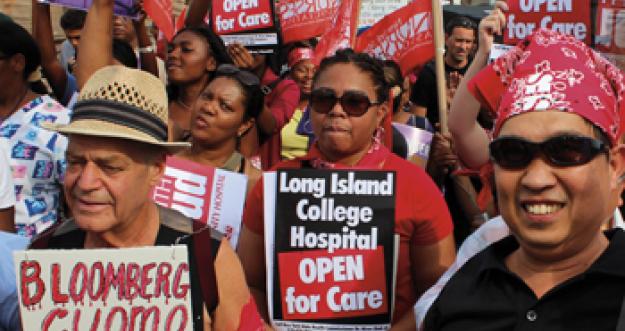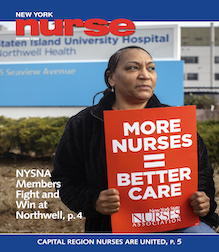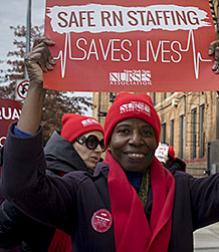
No one needs to tell a New York nurse that healthcare is in crisis in our state. You experience it every day. Inadequate staffing. Service cuts. Units closed. Hospitals shut down. New Yorkers in need of care they can’t get.
The consequences are shocking – and dangerous. Some nurses have been forced to care for as many as 16 patients at a time.
NYSNA nurses are fighting to deliver the care New Yorkers deserve under safe and respectful conditions. Winning our fight depends on understanding what’s causing the crisis in healthcare, and responding accordingly.
The root of the problem
It is the drive for growing profits that has led to today’s crisis in healthcare. For-profit companies and providers receive the majority of healthcare dollars nationwide. This is true even for nonprofit hospitals and even in states like New York where for-profit hospitals are legally forbidden (at least for now).
Hospitals spend much of their operational budgets on goods and services – like medical equipment and technology, facility maintenance and construction – that companies sell them. And, of course, all pharmaceutical companies, most insurance companies, and many physician practices also are for-profit entities making money on healthcare.
The results? A 2012 study published in the Journal of the American Medical Association estimated that wasteful, unnecessary or fraudulent practices account for 47 percent of total healthcare expenses in the U.S.
Yet for the last 40 years, since the introduction of HMOs in the 1970s, insurance companies and policymakers have promoted market-based approaches as the best way to deliver healthcare. They have pushed market “solutions” so steadfastly that by now it’s common wisdom that this makes sense – even though it’s patently false.
Markets are about profit and loss. They are not about health or care.
As economist and Nobel Prize winner Paul Krugman noted in 2009: “There are… no examples of successful healthcare based on the principles of the free market, for one simple reason: in healthcare, the free market just doesn’t work. And people who say that the market is the answer are flying in the face of both theory and overwhelming evidence.”
Under the market system, insurers have an incentive to get healthy people who need little care into their programs, to drop those with costly chronic conditions, and to build hurdles that make it harder for everyone to get care. That’s how they make money. Markets aren’t interested in the medically underserved or in rural areas where there’s little revenue to generate. The results? In the face of public cuts, hospitals in low-income areas and upstate are chronically underfunded; people suffer.
The medical arms race
The open for care movement. Brooklyn is the epicenter of New York’s healthcare crisis – and the center of our growing movement to keep hospitals open for care. We demand a moratorium on all hospital closures and cuts until state officials can guarantee that every New Yorker will have access to quality care in our communities. Pictured here, protesting the planned closings of Interfaith Medical Center and Long Island College Hospital. On August 20, in a hopeful step toward keeping LICH open, a judge called the hospital’s refusal to accept patients “a travesty” of its mission and invalidated its sale.
Many private hospitals are engaged in a medical arms race for a simple reason: advanced technology sells. The thing is, it also costs. Hugely expensive equipment leads to exorbitant bills, often with questionable health benefits. A recent study in the Journal of the American Medical Association showed that men with low-risk prostate cancer are no better off if they receive IMRT and robotic surgery than are those men whose doctors advise watchful waiting. The difference in results is in the price tag, in revenue for hospital and technology companies, not in health.
The difference is also in direct patient care. Hospitals across the country are cutting nursing staff to pay for the latest technology. And administrators are demanding that remaining nurses spend more time completing electronic medical records than giving care.
Smaller hospitals are simply left out. They can’t compete with the newest technology and slickest ads. And so they lose those patients who can afford the latest, even though that may not be medically necessary, or even best.
New York’s two-tiered healthcare system
The tale of two cities in healthcare in New York is not new. But the divide between the haves and have-nots in healthcare is growing to new proportions. And the consequences are stark. Hospital empires are catering increasingly to patients with the best insurance while they are offloading “unprofitable” patients with lesser or no insurance onto the public hospital system. Big chains collect handsome fees and use their revenue to consolidate and get even bigger: Public and safety-net hospitals – with their mission to care for every patient, regardless of their ability to pay – are left to struggle to care for more patients with fewer resources because of cuts in public funding.
This is particularly alarming given rising acuity. Studies show, and nurses know from their experiences every day, that many hospital patients are sicker today than they were in the past and their care is more complex. Safe staffing requires lower patient-to-nurse ratios, not greater.
Is the market the solution?
Both the Affordable Care Act (ACA) and the MRT (Medicaid Redesign Team) reforms in New York State rely on the “common wisdom” that competitive market forces will reduce costs, increase the availability of care, and improve quality and health results.
But we already know that this isn’t what happens. Market forces seek profit. And the ACA creates incentives for hospitals to merge and consolidate. And that, ironically, will undermine the very competition that market mechanisms are supposed to create to contain costs.
While the push for primary care and preventive care sounds like it will help promote greater health for all, the results are likely to be less positive. New and unregulated market forces will form as for-profit companies open medical practices, free-standing emergency rooms, MRI clinics, and other testing facilities. And bundled, or episode-based, payments for care will create incentives to provide less of the very care they are meant to yield.
If the problem is how to make more profit in healthcare, then the solution may be market based. But if the problem is making quality care readily available to all New Yorkers, then it most definitely is not.
For-profit chains knocking at the door
For-profit hospital chains keep getting bigger nationwide, and New York is mighty tempting territory for them. New York State’s Medicaid reforms and proposed changes to Certificate of Need (CON) programs rely on market mechanisms and the profit motive to “fix” the healthcare system’s troubles. This year, we successfully beat back a bill in Albany that would have let private equity firms experiment on five New York hospitals. And we stopped a bill that would have let Wall Street and hedge funds take over SUNY Downstate and other Brooklyn hospitals. They will, no doubt, try again.
Without a fight, the results for New Yorkers will not be pretty. Those with the insurance and resources to cover them will have ready access to costly care. Those without will go with less and less care as public hospitals have fewer resources to meet their essential mission of treating anyone seeking care. The consequences for nurses will be more patients, less time for quality nursing practice, and more administrative responsibilities like electronic medical record keeping.
Our union’s response
The fight for safe staffing. On May 21, more than 1,000 NYSNA nurses came together in the largest action for safe staffing in New York history. We convinced a majority of members in the state Assembly to sign on to our safe staffing bill. The hospital industry fought back hard and blocked a vote. But we’ve made this the No. 1 patient care issue in New York State – and we will be back to fight, and win, another day.
The drive to make money from healthcare hurts patients and nurses alike. We all understand that healthcare in America is in trouble. Too many people go without care or don’t get the care they need because they don’t have the insurance or the money to cover the costs.
It’s the profit motive that’s fueling a lot of the rising cost of healthcare. The solution isn’t giving freer rein to market forces; it’s putting people – patients and frontline providers, like nurses – first.
Changes in healthcare present us with the biggest challenges we’ve ever known. Everything we stand for – safe staffing, quality care for all New Yorkers, fair treatment and respect for nurses – is harder to accomplish in today’s environment than it has ever been. We can’t just hope for the best. We are changing as a union to make sure we have the strength to win the healthcare that all New Yorkers deserve – the healthcare that recognizes and respects our essential role as nurses.
Discover more on our agenda – and what it’ll take to build the strength to win.




